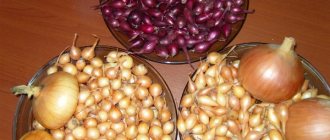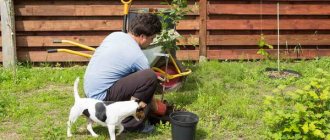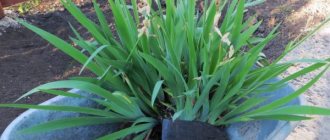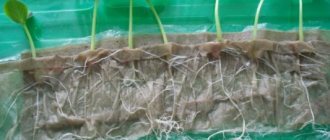Real summer residents do not stop at the cherished goal of “growing a tree” - they go further and plant a vineyard, although not always successfully. A couple of unsuccessful attempts to grow grapes according to the principle “like all bushes” leads to the idea that it is unrealistic to grow this crop in the country - there is no point in trying.
The reasons for failure must be dealt with once and for all: find out what a grape seedling needs after planting for successful acclimatization and rapid growth. There are rules and nuances that are generally known in traditional viticulture regions.
Optimal planting dates in different regions
Grapes are very popular in the Moscow region and central regions. Here it is necessary to focus on weather conditions, but in general, planting begins in the second half of May. You can plant plants in late April-early May, but then the seedlings are placed in a greenhouse.
The earliest planting begins in the South, where already in the second half of the month, winegrowers are planting cuttings and seedlings with might and main.
In Siberia and the Urals, spring planting of grapes is necessary 2-3 days after the standard planting period, when the frosts have passed and the plant is not in danger.
Dates according to the lunar calendar
This year 2021, according to the lunar calendar, the most favorable period for planting seedlings of the selected grapes is the month of April, or more precisely the period from the 11th to the 17th, and from the 21st to the 26th.
April is the best month for planting, so these days it is worth carving out some time for gardening work in order to enjoy the yield of your favorite grape variety in the future. This cannot always be done, but if it doesn’t work out these days, then you should at least avoid gardening during unfavorable times, and according to the lunar calendar 2021. The following periods are considered such:
- 6, 7 and 21 in March;
- 5 and 19 in April;
- 5 and 19 in May;
- 3, 4 and 17 in June.
In 2021, favorable days for planting grapes will be:
- March 3-5;
- March 17;
- March 27-28;
- April 1-2;
- April 7-8;
- 14th of April;
- April 28.
Among the unfavorable days of 2021:
- March 14th;
- March 22-23;
- April 19-22.
Is it possible to grow grapes in the Moscow region?
Contrary to popular belief, grapes are not so sissy. It is quite successfully grown by amateur gardeners in Siberia, the Urals, the Central Non-Black Earth Region and, of course, the Moscow region. There are many resistant grape varieties that are undemanding to heat, can withstand low negative temperatures, and in terms of yield and quality of berries are not inferior to the best European varieties.
In the Moscow region, grapes are one of the most profitable crops. It produces high and stable yields, up to 6–10 kg per bush, and sometimes up to 25–27 kg. This plant is early ripening, bears fruit in the second or third year of planting, and on any soil, tolerates high groundwater levels, and there are quite a few such areas in the Moscow region. It is easier to protect it from spring frosts than pome and stone fruit crops.
Growing grapes in the Moscow region is even easier than in the industrial viticulture zone:
- Due to the absence of viral diseases and pests of grapes in cool climatic conditions, there is no need for repeated treatments of bushes with chemicals.
- The methods of “dry” shelter for the winter developed by amateur gardeners are less labor-intensive than those used in the south of the country.
- Thick snow cover in the Moscow region creates additional protection in winter.
The taste of grapes grown in the Moscow region is in no way inferior to those from the south.
Pros and cons of spring planting
Of the main advantages of spring planting, it is worth noting the following:
- Acceptable temperatures. In the spring, especially in April, there is no need to experience relatively serious frosts, so the risk of seedling death after planting is eliminated.
- Survivability. Thanks to good weather conditions, the seedling goes through the adaptation period well, takes root, and thanks to this its resistance to low temperatures significantly increases. He's kind of being hardened.
- Preparation. There is quite a lot of time for advance preparation of the soil, which during the winter will have time to be well saturated with useful substances. Over time, they will move on to grapes that are better able to cope with weather conditions and even parasites.
Along with the advantages of spring planting, there are also disadvantages:
- Treatment. Before planting a seedling in the spring, the soil must be treated to remove harmful microorganisms and parasites, which wake up and become active just in the spring.
- Weather. It is difficult for weather forecasters to predict weather conditions recently, so the risk of frost in early spring still remains and this must be taken into account.
- Choice of variety. The choice of varieties in the spring is quite poor, since winegrowers try to sell them in the autumn. You will have to purchase seedlings in the fall and take care of them until the start of the spring planting period.
The planting time should be chosen based on personal capabilities and preferences, then the winegrower will have beautiful plants at any time.
How to save grape seedlings purchased in the fall for spring planting?
If you bought grape seedlings in the fall and did not have time to plant them before the onset of severe and constant frosts, there are three ways to keep them in good condition until spring.
Method 1: Plant the seedling in a container with soil, in a bucket, 5-liter bottle or pot. Water and store in the basement or cellar for the winter. At the end of March - beginning of April, bring the seedlings into a warm, bright room. The seedlings will begin to grow and by the time they are planted in their permanent location they will have large green shoots. Due to this, you increase the growing season.
Method 2: Place the seedlings in a container with damp sand and put them in the basement until spring. Make sure that the sand is always moist and the roots do not dry out. This method has a slight drawback. If your basement is not cold enough, then in the spring the seedlings begin to wake up, but it is still too cold outside for planting.
Method 3: A frequently used but very problematic method is storing seedlings in the refrigerator. The roots of the seedlings are wrapped in damp newspapers, packed in a plastic bag and stored on the bottom shelf, periodically checking the moisture content of the newspaper.
Choosing the right variety
Many beginners miss the moment of choosing a variety, which is a grave mistake. It is important to select a variety according to the weather characteristics in a particular region and personal preferences in terms of not only taste, but also care.
First, it’s worth understanding the ripening time, since different regions have different temperatures, and climatic conditions are not always suitable for the grape variety. The fruit may simply not ripen if there is not enough heat.
Frost resistance and weakness to various diseases are considered important indicators. Choose complex-tolerant grape varieties and various hybrid forms that have the most attractive characteristics. You can learn about the best frost-resistant grape varieties from this article.
What should the seedling be like?
There are two types of seedlings: vegetative and lignified, and before choosing, you should familiarize yourself with the main characteristics and features of each type:
- By vegetative we mean cuttings that were planted in early spring. It is often called green because by the next green period, when planting should take place, the cutting usually already has several green leaves.
- A one-year-old grape bush is called woody seedlings. In the fall it is dug up, after which it is stored in a cool place and always in damp sand. To preserve it, it is important that the humidity percentage in the room does not fall below 85 at all times, because under other conditions mold and other microbial organisms can develop.
How to care for grape seedlings
Immediately after planting, it is better not to disturb the seedling for 1-2 weeks - it is enough to monitor the ventilation of the shelter (if a greenhouse has been installed).
- Young grapes need watering: 1 bucket of warm, settled water per bush no more than once every 10 days. Under no circumstances should you water if there has been recent rainfall. Excess moisture for a grape bush is much more dangerous than drying out of the soil - young plants suffer from serious fungal diseases.
- At least 2-3 times per season, the vines should be treated with a fungicide to prevent fungi: mildew, oidium, anthracnose, etc.
- To improve soil conditions and good root growth, it is recommended to cover the tree trunk circle with mulch of straw, sawdust, etc.
- If you do not cover with mulch, the soil must be loosened regularly and watered more often.
- As they grow, the green shoots are tied to a peg stuck nearby, then to a trellis.
A vineyard is considered “young” for 3-4 years. Throughout this entire period, the bushes do not need feeding if the planting hole is thoroughly prepared.
In the video you can clearly see the process of planting grapes and learn about some of the nuances of caring for them.
Suitable landing site
The chosen location is of no small importance for the future of the grapes. It is desirable that this be a well-lit area of land where the plant will receive maximum solar energy. You should also take into account the following planting nuances:
- Planted cuttings should be located at a distance of 3-6 meters from large trees. This rule is due to the fact that trees strongly extract nutrients from the soil, and the grapes simply do not get the necessary elements for growth. If the root system has grown too much, then the distance must be increased.
- It is recommended to plant cuttings on the southern and western sides of buildings. Thus, plants will receive the necessary heat even at night - it is given off by the heat of buildings accumulated throughout the day. The cuttings will grow better and produce a good harvest faster.
- There is not always room to place a plant near a building, and then you should pay attention to elevated areas. It can be a slope on the southwest, west and south sides.
- Do not place cuttings in lowlands, because frosts and any temperature changes are felt most strongly there - the grapes may simply not withstand it.
- It is advisable to avoid places where groundwater is close to the soil.
Choosing a place to plant grapes
Planting grape seedlings
Taking into account the above rules, the place for planting grape seedlings should be sunny, protected from wind and drafts. It is preferable to choose the southern side, but if there is none on your site, then the sunniest one (the northern side is strictly excluded).
You should not plant grapes near trees that provide dense shade, as well as near the house itself or between buildings. This rule can only be broken if you are growing an ornamental variety and you are not interested in yield.
If you plan to expand your vineyard in the future, allocate more space for it in advance. The distance between bushes, depending on characteristics, growth vigor and other criteria, should be at least 3-4 meters. It is equally important to know the moisture and chemical composition of the soil. If there is excessive moisture, drainage will be necessary.
Soil drainage before planting grapes
Rocky soil in which water does not accumulate is acceptable, and potassium will help the bushes to overwinter better. Iron and magnesium in the soil are needed for photosynthesis, but nitrogen and calcium are needed only in moderate quantities.
It is recommended to plant grapes on plains, mountains and slopes; lowlands are not the most successful and favorable place. The permissible distance between garden trees and grape bushes is 3-4 places. At this distance, the shadow is not terrible, and the trees will additionally protect the bushes from dust, wind and other unfavorable conditions.
Requirements
It is necessary to take into account all the requirements that will help you get a good harvest. We will talk about them further.
At what depth should I plant?
The opinions of winegrowers vary greatly on this matter. Some believe that 50 cm holes are quite suitable, others are sure that the recess should be at least a meter deep. In moderate climatic conditions, gardeners prefer to plant cuttings to a depth of 70 cm.
At what distance should I plant?
The distances between cuttings, if several seedlings are planted, must be taken into account by the gardener. The distance depends solely on the type of grape. Thus, it is advisable to plant weak and medium-growing species at a distance of 1.3-1.5 m, while strong varieties require a slightly different approach. They require at least 1.8-2 m, and the most optimal would be 2.5 m, if the owner of the site has such an opportunity.
Insufficient distance will affect the quality and growth of the grapes, since the cuttings will not receive sufficient nutrition, lighting and ventilation. This seriously increases the risk of disease, and the yield will be significantly reduced. Also, thickened plantings age faster.
How and with what to fertilize the soil before the procedure?
In most areas, the soil does not contain a sufficient amount of natural nutrients and components, and if you choose the wrong place, then the growth of grapes remains a big question. To prevent the death of the plant, various diseases and increase immunity, it is necessary to well fertilize the area where the future vineyard will be located.
Experts recommend using mineral and organic fertilizers. You can make several layers using this type:
- chernozem 10-15 cm;
- a bucket of rotted manure;
- a layer of fertilizer of your choice (150-200 potassium, 400 g regular or 200 g double superphosphate);
- Additionally, you can use a couple of cans of wood ash;
- another layer of black soil.
Spring planting of grape seedlings in the Moscow region.
In central Russia, in the middle of the twentieth century, growing heat-loving grapes seemed like something out of science fiction. Thanks to our breeders, who have put incredible work into the grape business, we have the opportunity to enjoy healthy berries at our dacha near Moscow.
The following grape varieties are popular in the Moscow region: Alyoshenkin Dar, Pamyati Dombkovskaya, Pleven sustainable, Amursky breakthrough, Agat Donskoy, Augustine.
What we need to know to grow grape seedlings is this:
- choose varieties with a growing season of 100-120 days;
- in the spring we also plant cuttings or green seedlings;
- Seedlings are planted at ground temperature + 10 degrees.
- the place should be on the south side of your house, fences and other structures with a 1 m indentation for protection from northern winds and better warming up under the sun;
- It is best to grow seedlings on sandy and loamy soil;
- if clay predominates in the soil, then in the planting pits we make a drainage layer of crushed stone or broken brick;
- The soil should not be waterlogged;
Sprouts will take longer to take root if planting is delayed until later.
So, how to plant:
- We prepare a planting hole 30–45 cm deep, 1.5 * 1.5 m wide, put 4-5 buckets of compost, 1 shovel of wood ash, 4 buckets of sand into it and mix everything.
- We already know how to prepare seedlings. The method is suitable for both green annual plants and chubuk.
- In the center of the pit we create a hole 30 cm wide and 40 cm deep.
- Pour 2 buckets of water into it.
- We make a mound of soil and, straightening the roots, plant a seedling on it.
- The top bud of the shoot is left 5-8 cm underground.
- Plant the sprout at an angle if it is taller than the standard length.
- Cover the seedling with soil and make a hole around it and water it.
- To warm the soil, you can lay a black film over the root part.
After planting and adapting the seedling, feed it with phosphorus and potassium fertilizers.
Many people think that in the middle zone of our Motherland you can only get sour and small crops, but this is not so. Here, for example, are varieties that will survive frosts, and their clusters are large, and the berries are rich in juice: Northern Early, Summer Muscat, Arcadia, Muromets, Sharov's Riddle, Muscat Pleven, Radiated Kishmish, Kesha, Krasa Nikopol, Michurinsky, Kodryanka. You just have to believe in yourself and approach the matter competently!
Preparation of planting material
The choice between a seedling or a cutting depends solely on the needs and wishes of the owner of the site, but the plants will have to be prepared in any case.
Cuttings (chubuki)
First you need to leave the cuttings in a calm state at home for several days. It doesn’t matter whether they were purchased or were dug up by the winegrower in advance in the fall. They need to adapt a little to the temperature.
If the cuttings are grown and prepared independently, then you need to check their condition for mold, darkening or painful spots. If mold is detected, they can be washed in a solution of potassium permanganate, which is also disinfected for 30 minutes. This can be done even if the cutting is in perfect condition. After half an hour, the cuttings are washed with ordinary running water.
The next step is cutting to update the sections. At the same moment, winegrowers simultaneously check the middle of the cut, noting the color. The black and brown dried out center can be considered dead. Make sure that the cuts are smooth.
After this, they are soaked, furrowed, treated with a root formation stimulator, and only then are they put into germination.
To learn how to root a grape cutting, watch the following video:
Saplings
With seedlings the situation is a little simpler. Preparation begins 1-2 days in advance, it includes proper pruning of the root system and soaking in a growth stimulator solution.
Sometimes winegrowers replace purchased stimulants with a solution of honey and water in a ratio of 1 tbsp. l. for 1 l. This will provide the seedling with an excellent start and allow it to quickly take root, which means it will become stronger.
Preparing grape seedlings for planting
Once you have decided on the grape variety, choose a place for it on the site. Identical varieties should grow side by side, and not mixed with others. Immediately before planting, refresh the roots by cutting them at a distance of at least 10 cm from the trunk. Then dip them in a root growth stimulator: fumar, sodium humate, succinic acid, etc., use the dosage according to the instructions.
Potassium humate for grapes
If the root system has become weakened over the winter, place the seedlings in water with the addition of a growth stimulator for 2 hours.
The shoots also need to be renewed and excess buds should be cut off, leaving only 4-5 of the strongest ones, so the plant will not waste extra energy on unnecessary buds. A week before planting, the roots can be treated with a creamy mixture of manure and clay. You can store them wrapped in burlap until planting.
Methods of planting seedlings
There are many ways to plant grapes, and each of them has its own disadvantages and advantages, which should be taken into account when choosing.
Classical
With the classic method, the seedlings are washed well before planting. Cut the container (if it was in a container), place the seedling at the bottom of the hole, and on the north side there is a peg for tying, fill the plant on top of the earthen clod, compact it and water it with warm water. Next, the hole is filled to the height of the first leaf, but this is after watering.
About the features of planting grapes in spring, watch the following video:
On the trellis
This method allows you to organize the vineyard well. For this scheme, it is necessary to prepare the place in advance by installing trellises in the required order, depending on the number of seedlings. And then the landing occurs, as in the first option.
Maintain a distance of at least 2 m, make supports from metal pipes with a diameter of 10 cm. For tying, use a wire with a diameter of 5 cm - it is important that it is in a plastic sheath.
On the ridges
This method is well suited for northern regions, as it provides maximum warmth and eliminates flooding. To begin with, prepare a trench (located in a southerly direction) 10 m long, 1 m wide and 30-40 cm deep.
After this, soil is poured above 30-35 cm from the ground, mulched, insulated, heat-supporting material is placed, and cuttings are planted 40 cm deep. A metal pipe with a diameter of 30 cm is used for irrigation.
In the greenhouse
Planting in a greenhouse differs only in that the seedlings are watered once a week and well insulated. It is advisable to reduce watering as flowering and fruit formation occur.
In containers
In the northern regions, grapes are planted in containers. To do this, the cuttings are planted in plastic bags without a bottom, but they must be placed on a suitable tray. Their standard size is 30 by 40 cm. Humus and deciduous soil are used as soil; before planting, the roots are sprinkled with clay and manure (you can use Kornevin), and left for storage at home.
When the first buds appear, the packages are sent to an area located in the shade for a couple of days, after which they are moved to a sunny area. When the weather becomes warm and most suitable for planting grapes, the seedlings are buried in the ground.
Moldavian
The long vine is twisted and tied with a strong rope, after which it is planted in the hole. In this case, no more than 2-3 buds are left on the surface. Caring for the plant is the same as with the classical method.
Thickening
When thickening by 1 sq. m, at least 7 bushes are grown. This method is more suitable for warm areas. The branches are cut short enough, planted in the classical way, and grown in a bush form.
How to plant grape seedlings in spring step by step
When the temperature conditions become favorable and the threat of frost has passed, they begin to plant seedlings in open ground.
Conventionally, this process can be divided into three important points:
- preparing the planting hole;
- planting grapes;
- caring for the seedling.
Watering the seedling during planting
When preparing a planting hole, the step-by-step work algorithm is as follows:
- The landing site is being selected.
- The space around is cleared, grapes are very demanding of light and heat, you need to choose a place so that nothing shades the plant.
- The dimensions of the planting hole are 80x80 cm, the depth depends on the type of soil - for loam and chernozem it is usually 80 cm, for sand and sandy soils the depth can reach 1 meter.
- The distance from the fence to the plant should be 2-2.5 meters, to trees 6-8 meters, to tall shrubs 3-4 meters.
- In chernozem and loams at the bottom you need to make a layer for drainage; here it is better to use expanded clay or pebbles. For sandy soils this is not necessary; here, on the contrary, you need to add up to 25-30 cm of clay to retain moisture.
- The second layer is made of fertile soil, it is poured up to 15 cm high and trampled down tightly, ash and mineral fertilizers are added to it.
- It is recommended to fill the third layer with fertile soil, and the seedling will be planted on it.
- The rest of the volume is covered with earth and compacted.
Subsequent care of grapes after planting
After planting grapes, they must be carefully looked after. We will talk further about how to do this correctly.
Watering
After planting, at least 10-14 days must pass for the first watering. It is advisable to do this in the evening and pour 2-3 buckets of warm water under the bush. Subsequent watering occurs after two weeks, and then it should be based on the drying of the substrate.
Loosening
Loosening is considered an obligatory step in grape care, since this is how the substrate allows air to pass through to the root system. The soil is loosened periodically; this can be eliminated by sprinkling the soil around the plant with a light layer of straw or hay.
Top dressing
With proper planting, there is no need to constantly fertilize the soil. This is only required if the soil was poor and the grapes grow quite slowly and poorly overall. Then organic and mineral fertilizers are used, which are diluted in water. Typically, the manufacturer indicates the dosage on the packaging and should be followed.
Read more about what fertilizer is suitable for grapes in the spring in the next article.
Treatment against pests and diseases
Spraying grapes in the spring against pathogens must be carried out before the buds open. Experts recommend using fungicidal preparations that treat not only the vine, but also the sleeves, trunk and soil at the base. If there are a lot of pests, then the procedure should be repeated after 10 days.
Trimming
Pruning is done at the beginning and end of summer. The rootstock is removed, as are the top roots of the seedlings. An important step is cutting off the first roots from the surface, for which the top layer of soil is removed to a depth of 20 cm.
After the work has been done, the hole must be filled up again. You should not get carried away with pruning, because real and complete pruning is done only in the 3rd year of plant growth.
Garter
For long vines, staking is carried out using long wooden pegs or trellises. You can also use metal pipes as a base.
Wintering
Insulation is simply necessary for young seedlings. In winter, the grapes are placed in a trench and then mulched. If we talk about thickness, then it should be chosen according to the climatic conditions in a particular region.
Planting grape seedlings in open ground in spring
One of the main questions is how to properly plant grape seedlings in the spring. The important thing is the correct preparation of planting material and compliance with agricultural technology during the main work. The spring vineyard planting period has its positive and negative sides. Here it is important to correctly determine the most suitable time for planting, both in terms of timing and weather conditions, so that the seedling feels comfortable in the open ground.
Pros and cons of spring planting seedlings
The period of planting grapevines in open ground should be understood as the time when the risk of night frosts is minimized, and the average daily temperature reaches +12-15 degrees.
Grape seedlings in containers before planting
Such conditions allow us to count on the following points and factors:
- The grape bush will gain the necessary strength to go into winter, its root system will develop and will be able to not only provide it with nutrients, but will also ensure the first harvest the following year.
- In the spring there is time and it is easier to grow a viable seedling from a shank. If all measures are followed, developed material for planting can be obtained from the cuttings after storage.
- Warmth and a sufficient amount of moisture allow you to better prepare the place for planting and prepare materials for fertilizing and mulching.
- It is more profitable to grow varieties during spring planting - in the second year the plant begins to bear fruit, and in the third year it is able to produce a full harvest. When planted in autumn, the bushes begin to bear fruit with a delay of at least 1 year.
- It is also better to plant a bush in the spring because it is less at risk of dying from frost; fungal diseases are practically not found on such bushes.
Attention! For planting in the spring, viable seedlings are prepared and stored in the basement, which significantly increases the survival rate of plants.
In addition to the positive aspects, you need to be prepared for unfavorable moments:
- When the air temperature rises sharply in the spring, as has been observed in the last few years, a lack of moisture may occur and additional watering will be required.
- Planting grapes in the spring will require additional mulching of the soil and the application of organic and mineral fertilizers in large quantities.
- When purchasing seedlings at the market or at a garden center, there is a high probability of purchasing diseased or frost-damaged plants.
- When planting plants with green leaves, they become the object of attention of animals and insects, so you will have to carefully monitor the shoots and provide protection from uninvited guests.
Germinated seedlings in plastic bottles
Optimal planting dates in different regions
When grapes are planted in open ground in the spring, compliance with the timing of planting seedlings is important.
For the southern regions of the country, the optimal time occurs in the second ten days of April. At this time, the air temperature warms up to +15 degrees, while the soil temperature can reach +20-22 degrees in sunny areas.
Important! However, at this moment the risk of night frosts is extremely high, so it is recommended that when planting in the early stages, provide material to cover the plants at night.
For the Middle Zone and Moscow region, the month of May is considered optimal for spring planting in open ground. Usually this is the second or third decade, when spring rains sufficiently saturate the soil and the air warms up to 15-17 average daily degrees.
For the Urals and Siberia, it is recommended to use locally selected varieties, but here, due to the fact that spring is shorter than in the west, planting dates may shift, up to mid-June. It is recommended to develop a detailed grape planting schedule based on medium-term weather forecasts and observation results over the past 5-10 years. For these regions, it is recommended to use a vine that has a well-developed root for planting. This will allow you to get a strong, healthy bush in the fall.
Possible mistakes when planting grapes in spring
Even experienced winegrowers can make mistakes when planting young seedlings. Among the most popular, it is worth noting the following points:
- strong deepening (the bush will grow poorly);
- seedlings from other regions (local climatic conditions are not suitable for them and they die);
- inappropriate place (little light, space, flooding and frost interfere with the normal growth of the plant);
- planting strong and weak-growing varieties nearby (some prevent others from developing).
Useful tips and tricks
Use trusted suppliers or prepare seedlings yourself. It would be a good idea to prepare the soil for planting in advance in order to deal with other stages of care in the future.
Try to adhere to these rules when planting, so as not to make a mistake with the depth or distance between plants, because this critically affects the growth of the seedling and the future harvest.
Plant grapes at the right time and under the right weather conditions, otherwise a favorable outcome can be forgotten.
Growing grapes is a rather complex and painstaking process that requires careful study and consideration of the needs of a particular variety. However, hard work is rewarded when it comes time to harvest. With the right approach, the quantity and quality of fruits will always be at their best.
0
0
Copy link
Preparing the soil for planting grapes
The soil should be prepared for planting in advance, starting in the fall, so it will have time to settle, rest, and become saturated with moisture over the winter. Planting is considered the most effective - i.e. transferring earth to a depth of 60-80 cm from top to bottom and vice versa. At the same stage, you can add fertilizers, humus or manure.
Preparing the soil for planting grapes
If the soil is heavy (for example, chernozem), crushed stone, expanded clay or crushed brick (white) must be distributed to the specified depth so that there is no stagnation of water. The top layer of soil must be diluted with river sand.
Immediately before planting grape seedlings, you need to find out the chemical composition of the soil, its pH level, and nutrient content. For analysis from a local area, 1-1.5 kg of soil will be enough. Fertilizers are applied if necessary, based on the results of the examination and taking into account what grape variety will grow on it. So the pH level can vary from 5.5 to 7.5, and is adjusted with manure and various fertilizers.











